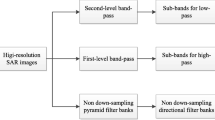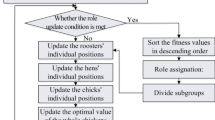Abstract
Synthetic aperture radar (SAR) image segmentation is an important problem of the realm of image segmentation. In this study, a novel SAR image segmentation algorithm using a multi-objective evolutionary algorithm based on decomposition with non-local means denoising (MISD) is proposed. The novelty of MISD lies in the following issues: (1) an effective multi-objective method with decomposition to solve SAR image segmentation; (2) in order to denoise the SAR images and retain the details, we employ non-local means to remove the noise. The multi-objective decomposition method makes MISD have lower computational complexity. In order to evaluate the performance of the new method, we compared the results with three other popular segmentation approaches on four simulated and two real SAR images. In our experiments, the new method can always find better results, which means MISD is a promising SAR image segmentation method.











Similar content being viewed by others
References
Baraldi A, Panniggiani F (1995) A refined gamma MAP SAR speckle filter with improved geometrical adaptivity. IEEE Trans Geosci Remote Sens 33(5):1245–1257
Buades A, Coll B, Morel JM (2005) A review of image denoising algorithms, with a new one. Multiscale Model Simul 4(2):490–530
Deb K, Agrawal S, Pratap A, Meyarivan T (2002) A fast and elitist multiobjective genetic algorithm: NSGA-II. IEEE Trans Evol Comput 6(2):182–197
Deledalle A, Denis L, Tupin F (2009) Iterative weighted maximum likelihood denoising with probabilistic patch-based weights. IEEE Trans Image Process 18(12):2661–2672
Dong Y, Forster BC, Milne AK (2003) Comparison of radar image segmentation by Gaussian- and Gamma-Markov random field models. Int J Remote Sens 24(4):711–722
Frost VS, Stiles JA, Shanmugan KS, Holtzman JC (1982) A model for radar images and its application to adaptive digital filtering of multiplicative noise. IEEE Trans Pattern Anal Mach Intell 4(2):157–166
Gong MG, Zhang LN, Jiao LC, Gou SP (2007) Solving multiobjective clustering using an immune-inspired algorithm. IEEE Congr Evolut Comput, Singapore, 25–28 September, 15–22
Gong MG, Ma LJ, Zhang QF, Jiao LC (2012) Community detection in networks by using multiobjective evolutionary algorithm with decomposition. Phys A 391:4050–4060
Goodman J (1976) Some fundamental properties of speckle. J Opt Soc Am 66(11):1145–1150
Handle J, Knowles J (2007) An evolutionary approach to multi-objective clustering. IEEE Trans Evol Comput 11(1):56–76
Haris K, Efstratiadis SN, Maglaveras N et al (1998) Hybrid image segmentation using watersheds and fast region merging. IEEE Trans Image Process 7(12):1684–1699
Hartigan JA, Wong MA (1979) A K-Means clustering algorithm. Appl Stat 28(1):100–108
Hubert L, Arabie P (1995) Comparing partitions. J Classif 2(1):193–218
Ishibuchi H, Sakane Y, Tsukamoto N, Nojima Y (2009) Adaptation of scalarizing functions in MOEA/D: an adaptive scalarizing function-based multiobjective evolutionary algorithm, lecture notes in computer science 5467: evolutionary multi-criterion optimization—EMO 2009, Springer, Berlin, pp 438–452
Ishibuchi H, Sakane Y, Tsukamoto N, Nojima Y (2009) Effects of using two neighborhood structures on the performance of cellular evolutionary algorithms for many-objective optimization. Proceedings of 2009 IEEE congress on evolutionary computation, Trondheim, Norway, pp 2508–2515
Ishibuchi H, Sakane Y, Tsukamoto N, Nojima Y (2009) Evolutionary many-objective optimization by NSGA-II and MOEA/D with large populations. Proceedings of 2009 IEEE international conference on systems, man, and cybernetics, San Antonio, pp 1820–1825
Ishibuchi H, Sakane Y, Tsukamoto N, Nojima Y (2010) Simultaneous use of different scalarizing functions in MOEA/D. Proceedings of genetic and evolutionary computation conference—GECCO 2010, Portland, pp 519–526
Jain K, Duin RP, Mao JC (2000) Statistical pattern recognition: a review. IEEE Trans Pattern Anal Mach Intell 22(1):4–37
Klawonn F, Keller A (1998) Fuzzy clustering with evolutionary algorithms. Int J Intell Syst 13(10–11):975–991
Kuan D, Sawchuk A, Strand T, Chavel P (1987) Adaptive restoration of images with speckle. IEEE Trans Acoust Speech Signal Process 35(3):373–383
Lee JS (1980) Digital image enhancement and noise filtering by use of local statistics. IEEE Trans Pattern Anal Mach Intell 2:165–168
Lee JS (1981) Refined filtering of image noise using local statistics. Comput Vis Graph Image Process 15:380–389
Lee CH, Zaïane OR, Park HH, Huang JY, Greiner R (2008) Clustering high dimensional data: a graph-based relaxed optimization approach. Inf Sci 178(23):4501–4511
Lemarechal C, Fjortoft R, Marthon P, Cubero-Castan E, Lopes A (1998) SAR image segmentation by morphological methods. In: Proceeding of the SPIE, Barcelona, Spain, 21 September, vol 3497, pp 111–121
Leung SH, Wang SL, Lau WH (2004) Lip image segmentation using fuzzy clustering incorporating an elliptic shape function. IEEE Trans Image Process 13(1):51–62
Li H, Zhang Q (2009) Multi-objective optimization problems with complicated Pareto sets MOEA/D and NSGA-II. IEEE Trans Evol Comput 13(2):284–302
Lopes A, Touzi R, Nezry E (1990) Adaptive speckle filters and scene heterogeneity. IEEE Trans Geosci Remote Sens 28(6):992–1000
Maulik U, Bandyopadhyay S (2002) Performance evaluation of some clustering algorithms and validity indices. IEEE Trans Pattern Anal Mach Intell 24(12):1650–1654
Miettinen K (1999) Nonlinear multi-objective optimization. Kluwer, Norwell, MA
Praditwong K, Yao X (2006) A new multi-objective evolutionary optimisation algorithm: the two-archive algorithm. Proceedings of the 2006 international conference on computational intelligence and security Guangzhou, China, vol 1. IEEE Press, pp 286–291
Praditwong K et al (2011) Software module clustering as a multi-objective search problem. IEEE Trans Softw Eng 37(2):264–282
Shi J, Malik J (2000) Normalized cuts and image segmentation. IEEE Trans Pattern Anal Mach Intell 22(8):888–905
Tang K, Mei Y, Yao X (2009) Memetic algorithm with extended neighborhood search for capacitated arc routing problems. IEEE Trans Evol Comput 13(5):1151–1166
Yang D, Jiao LC, Gong MG, Liu F (2011) Artificial immune multi-objective SAR image segmentation with fused complementary features. Inf Sci 181(13):2797–2812
Zeng J, Feng W, Xie L, Liu ZQ (2010) Cascade Markov random fields for stroke extraction of Chinese characters. Inf Sci 180(2):301–311
Zhang Q, Li H (2007) MOEA/D: a multi-objective evolutionary algorithm based on decomposition. IEEE Trans Evol Comput 11(6):712–730
Zhang Q, Liu W, Tsang E, Virginas B (2010) Expensive multiobjective optimization by MOEA/D with Gaussian process model. IEEE Trans Evol Comput 14(3):456–474
Acknowledgments
This work was supported by the Program for New Century Excellent Talents in University (No. NCET-12-0920), the National Natural Science Foundation of China (Nos. 61272279, 61001202 and 61203303), the Fundamental Research Funds for the Central Universities (Nos. K5051302049, K5051302023, K5051302002 and K5051302028), the Provincial Natural Science Foundation of Shaanxi of China (No. 2011JQ8020) and the Fund for Foreign Scholars in University Research and Teaching Programs (the 111 Project) (No. B07048).
Author information
Authors and Affiliations
Corresponding author
Rights and permissions
About this article
Cite this article
Li, Y., Wei, Y., Wang, Y. et al. Multi-objective evolutionary for synthetic aperture radar image segmentation with non-local means denoising. Nat Comput 13, 39–53 (2014). https://doi.org/10.1007/s11047-013-9399-0
Published:
Issue Date:
DOI: https://doi.org/10.1007/s11047-013-9399-0




